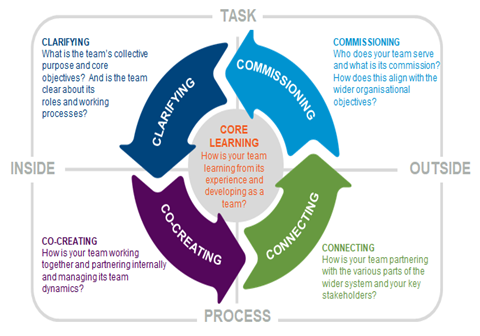Odgers Berndtson Partner Gary Payne talks about why companies need to articulate ESG (Environmental, Social and Governance) strategies and how Systemic Team Coaching can play an integral part in helping leadership teams balance their business priorities against ESG needs.
For most of history, publicly traded companies have defined their purpose rather narrowly: they existed first and foremost to serve shareholders, and their interactions with customers, employees, governments, suppliers, the environment, and wider communities were subordinated to this agenda. Now, however, the definition and scope of a company’s purpose is clearly changing. Throughout the business world, people are asking why shareholders, many of whom have only passing affiliation with the company, should be prioritized over stakeholders whose lives are deeply tied to the company’s existence and decisions?
This can be a tricky topic. Conversations about ESG and stakeholder management can at times be muddied by idealism, cynicism, or both. But getting ESG right isn’t just the right thing to do, it’s an important part of running a profitable business. Every organization and leadership team must now take the time to think more broadly about how they can interact with and capitalize upon the interlocking network of constituencies to which they relate.
In this article, I talk about why companies should embrace ESG, and then I discuss the ways that Systemic Team Coaching can help companies successfully integrate ESG values and strategies across the breadth of their organizations.
Five Reasons to Embrace ESG
- It helps you attract talent
Companies are not alone in re-thinking the primacy of profit. Today’s employees are increasingly likely to conceptualize their jobs as extensions of their personal identities. And as a result, they tend to evaluate their decisions based on factors separate to their own financial well-being. Employees want to work toward things that make them feel purposeful and that contribute to the greater good of society; many are even willing to take pay cuts in order to work for organizations whose missions and values align with their own.
Companies who acknowledge this, who codify and try to live up to the values espoused by their employees, will find it easier to attract and retain talent. Companies who fail to do so may find employees simply walking off the job, as was recently the case at Amazon, Google, Microsoft, and Wayfair.
- It helps you attract customers
Similarly, customers are evaluating their purchasing decisions based on the way brands and products interact with their personal identity rather than solely evaluating the quality or cost of the item in question. A 2018 Statista survey found that 90 percent of U.S. consumer would (a) boycott a brand that engaged in what they saw as unethical business decisions, (b) go out of their way to buy a product that has environmental benefits, and (c) purchase products because a company has advocated for issues they agree with.
- It helps you attract investors
ESG has become so mainstream that investors now consider their own brand impacted by the ESG commitments of the companies they invest in. Globally, eighty-four percent of asset owners either take a company’s sustainability performance and ESG strategies into account when making investment decisions or plan to. Some 30% of the world’s professionally managed assets (amounting to more than $30 trillion in value) are subject to ESG criteria.
- It helps you understand your true risk exposure
In our current legal climate, companies that too-narrowly define their stakeholders can be blindsided by foreseeable but unforeseen risks. This was perhaps best demonstrated by BP’s experience following the 2010 Deepwater Horizon Oil Spill, the largest marine oil spill in world history. While BP and its partners were designing the Deepwater Horizon Platform, they did not think that the Gulf Coast’s fishing industry (one of the largest fisheries in the United States) was at all relevant to their operation. However, when the disaster wreaked havoc on the fishing industry, destroying habitats and livelihoods, BP ended up paying these fisheries (and related victims) $7.8 billion in damages—almost bringing down one of the largest companies in the world as a result.
The lesson? Even if you don’t choose to recognize the full breadth of your stakeholder population, the courts, not to mention public opinion, often will.
- It positions your company to think about value in the long term
Companies that factor environmental and community impacts into their overall performance evaluations tend, by the very nature of these considerations, to think in longer terms than those who focus primarily on quarterly profits. This in turn decreases risk while often creating unforeseen sources of value for companies.
Using Systemic Team Coaching (STC) to Drive ESG Strategy
How do you go about implementing a solid ESG plan? How do you drive those values down through your organization, embedding a sense of corporate responsibility into the company’s culture? How do you manage your duties to non-financial stakeholders while continuing to provide value to shareholders? Who gets prioritized? When? How does the balance work?
Getting ESG right is hard, but systemic team coaching can help produce great results by helping teams evaluate the systems that they interact with, identify the stakeholders involved in those systems, and develop strategies that accommodate a wide array of stakeholder needs. In other words, STC coaches help teams pluralize their understanding of value and success.
What is Systemic Team Coaching?
Systemic Team Coaching was developed by Dr. Peter Hawkins, who in his book Leadership Team Coaching, defines the practice thus:
“Systemic team coaching is a process by which a team coach works with a whole team, both when they are together and when they are apart, in order to help them improve both their collective performance and how they work together, and also how they develop their collective leadership to more effectively engage with all their key stakeholder groups to jointly transform the wider business.”
We work with leaders and teams to define their function in relation to the function of their wider organization and that organization’s impacts on a wide array of stakeholders. We help teams work together to improve their collective performance, placing special emphasis on how a team’s interaction approaches, communications, values, incentive structures and goals can be further aligned to the needs of the business and the needs of the wider stakeholder community.
How it works: The Five Disciplines of High Value Creating Teams

The Five Disciplines of High Value Creating Teams
Graphic courtesy of the Global Teams Coaching Institute
Also developed by Peter Hawkins, the Five Disciplines of High Value Creating Teams is a highly practical STC framework that gives teams guidance on how and where to develop their effectiveness.
- Clarifying
Clarifying is the process of developing a set of agreed-upon objectives, and it refers to what the team needs to focus on in order to drive strategy. This typically includes addressing the team's purpose, vision, strategy, objectives, roles, and responsibilities. As coaches, we work with the team to clarify their tasks, their wider purpose, and the methods they intend to utilize—making sure that the company’s core business is weighted alongside diversity and other ESG concerns.
- Commissioning
Commissioning refers to agreeing upon a relationship between a team’s objectives and its stakeholders. For a team to successfully meet its business goals while also pursuing meaningful ESG strategies, it needs to have a clear understanding of stakeholder requirements and to articulate a success criteria that takes these requirements into account. In this phase of coaching, our team coaches work to expand the team’s understanding of its relationship to its wider stakeholder system, especially as it relates to the ESG strategy.
- Co-creating
Co-creating refers to teamwork and teamwork methodologies. Either consciously or not, all teams work together to build their own behavioral norms and value structures that, taken together, help determine their collective performance. In order to maximize that performance, and to create the healthiest possible workplace culture, our coaches work with teams to help them consciously build the teamwork methodologies that work for them and will generate the most value.
- Connecting
Connecting is the process of combining the first three disciplines in such a way that ensures effective stakeholder engagement. It means identifying all stakeholders, defining their unique relationships, and building the appropriate strategies to serve them. Ultimately, the term stakeholder includes an incredibly wide range of people and groups, each of which requires slightly different things from your organization. Some of them (e.g. employees and suppliers) provide value to the team; others (e.g. communities and shareholders) rely on the team to create value for them. Managing these relationships is the responsibility of the whole team not just the team leader.
- Core Learning
Core learning refers to how the team needs to continually learn and adapt in order to meet the evolving needs of the market, the organization, the team itself, and its stakeholders. One of the challenges of establishing an ESG strategy is coming to terms with the fact that your stakeholders will evolve alongside your operations. Opening new business units, launching new product lines, relocating teams to new locations, expanding into new markets—all of these core aspects of doing business will change the inventory of stakeholders that have to be served by both local and senior leadership teams.
Team coaches help the team step away from their day-to-day tasks and reflect upon their performance processes. The goal here is to codify not just specific lessons the team has learned but also the process by which they were learned so that the team can begin to coach themselves. By focusing on the process of learning rather than simply the lessons themselves, teams prepare themselves to react to the fluid and unforeseeable needs of the future. This stage of coaching also involves supporting and developing the processes and performance of every team member—identifying strengths and weaknesses and coming up with tactics for future situations.
For teams to perform at their best and cast the widest possible net of value for the widest possible suite of stakeholders, they need to be effective in all five of these disciplines.
Conclusion
Systemic coaching can help leadership leaders and their teams improve their collective value-creating performance, allowing their organizations to work toward a pluralized set of goals that provide simultaneous benefit to a wide variety of stakeholder groups.
In working with clients across the industry spectrum, we’ve noticed that nearly every team and organization has stakeholders of whom, for one reason or another, they are either unaware or are potentially impacted by unrecognized ESG concerns. Systemic Team Coaching is an excellent approach to ensuring the maximum effectiveness of a company’s ESG strategy.



